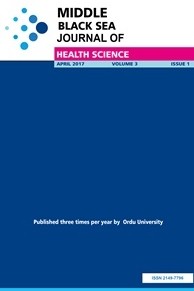Frequency of Paroxysmal Nocturnal Hemoglobinuria in Patients with Lymphoma
Paroxysmal nocturnal hemoglobinuria, PNH, lymphoma, cytometry, FLAER
Frequency of Paroxysmal Nocturnal Hemoglobinuria in Patients with Lymphoma
Paroxysmal nocturnal hemoglobinuria, PNH, lymphoma, cytometry, FLAER,
___
- 1. Bektas M, Copley-Merriman C, Khan S, Sarda SP, Shammo JM. Paroxysmal nocturnal hemoglobinuria: role of the complement system, pathogenesis, and pathophysiology. J Manag Care Spec Pharm. Aralık 2020;26(12-b Suppl):3-8.
- 2. Swerdlow SH, Campo E, Pileri SA, Harris NL, Stein H, Siebert R, et al. The 2016 revision of the World Health Organization classification of lymphoid neoplasms. Blood. 2016;127(20):2375-90.
- 3. Hillmen P, Muus P, Röth A, Elebute MO, Risitano AM, Schrezenmeier H, et al. Long-term safety and efficacy of sustained eculizumab treatment in patients with paroxysmal nocturnal haemoglobinuria. Br J Haematol. 2013;162(1):62-73.
- 4. Parker C, Omine M, Richards S, Nishimura J, Bessler M, Ware R, et al. Diagnosis and management of paroxysmal nocturnal hemoglobinuria. Blood. 2005;106(12):3699-709.
- 5. Socie G, Mary JY, Gramont A, Rio B, Leporrier M, Rose C. et al. Paroxysmal nocturnal hemoglobinuria: long-term follow-up and prognostic factors. French Society of Haematology. Lancet. 1996;348(9027):573-7.
- 6. Borowitz MJ, Craig FE, Digiuseppe JA, Illingworth AJ, Rosse W, Sutherland DR, vd. Guidelines for the diagnosis and monitoring of paroxysmal nocturnal hemoglobinuria and related disorders by flow cytometry. Cytometry B Clin Cytom. 2010;78(4):211-30.
- 7. Guc D, Canpinar H, Kucukaksu C, Kansu E. Expression of complement regulatory proteins CR1, DAF, MCP and CD59 in haematological malignancies. Eur J Haematol. 2000;64(1):3-9.
- 8. Meletis J, Terpos E, Samaekos M, Meletis C, Apostolidou E, Komninaka V. et. al. Red Cells with Paroxysmal Nocturnal Hemoglobinuria-phenotype in Patients with Acute Leukemia. Hematology. 2002; 7(2):69-74.
- 9. Kirito K. Expansion of paroxysmal nocturnal hemoglobinuria clones in MPLW515L mutation harboring primary myelofibrosis. Ann Hematol. Kasım 2020;99(11):2707-9.
- 10. Van Voolen GA, Hellstrom HR, Nelson DA. Paroxysmal nocturnal hemoglobinuria and the myeloproliferative syndrome. Ann Intern Med. 1982;96(6 Pt 1):792.
- 11. Vyrides N, Douka V, Gavriilaki E, Papaioannou G, Athanasiadou A, Neofytou S, et al. Paroxysmal nocturnal hemoglobinuria and myelodysplastic syndrome: Disappearance of cytogenetic abnormalities. Cancer Genet. 2021;250-251:1-5.
- 12. Dunn DE, Tanawattanacharoen P, Boccuni P, Nagakura S, Green SW, Kirby MR, et al. Paroxysmal nocturnal hemoglobinuria cells in patients with bone marrow failure syndromes. Ann Intern Med. 1999;131(6):401-8.
- 13. Meletis J, Terpos E, Samarkos M, Meletis C, Konstantopoulos K, Komninaka V, vd. Detection of CD55 and/or CD59 deficient red cell populations in patients with aplastic anaemia, myelodysplastic syndromes and myeloproliferative disorders. Haematologia (Budap). 2001;31(1):7-16.
- 14. Iwanaga M, Furukawa K, Amenomori T, Mori H, Nakamura H, Fuchigami K, vd. Paroxysmal nocturnal haemoglobinuria clones in patients with myelodysplastic syndromes. Br J Haematol. 1998;102(2):465-74.
- 15. Christou T, Subramanian S, Fung C. Paroxysmal nocturnal hemoglobinuria preceding malignant lymphoma. Arch Intern Med. 1987;147(2):377-8.
- 16. Ligorsky RD, Schaffner S, Oliver J, Oliver D, Lavine D. Unusual association between non-Hodgkin’s malignant lymphoma and a PNH-like defect in the red cell. Am J Med. 1994;96(4):395-6.
- 17. Lanza F, Lazzari MC, Brambilla P, Di Martino G, Spedini P. An unusual association of paroxysmal nocturnal hemoglobinuria, myelodysplastic syndrome, and diffuse large B-cell non-Hodgkin lymphoma in a Caucasian man. Ann Hematol. 2016;95(9):1555-7.
- 18. Hertenstein B, Wagner B, Bunjes D, Duncker C, Raghavachar A, Arnold R. et al. Emergence of CD52-, Phosphatidylinositolglycan-Anchor-Deficient T Lymphocytes After In Vivo Application of Campath-1H for Refractory B-Cell Non-Hodgkin Lymphoma. Blood. 1995;86(4):1487-1492.
- 19. Taylor VC, Sims M, Brett S, Field MC. Antibody selection against CD52 produces a paroxysmal nocturnal haemoglobinuria phenotype in human lymphocytes by a novel mechanism. Biochem J. 15 Mart 1997;322 (Pt 3):919-25.
- 20. Fukuda H, Seya T, Hara T, Matsumoto M, Kinoshita T, Masaoka T. Deficiency of complement decay-accelerating factor (DAF, CD55) in non-Hodgkin’s lymphoma. Immunol Lett. Ağustos 1991;29(3):205-9.
- 21. Seya T, Matsumoto M, Hara T, Hatanaka M, Masaoka T, Akedo H. Distribution of C3-step regulatory proteins of the complement system, CD35 (CR1), CD46 (MCP), and CD55 (DAF), in hematological malignancies. Leuk Lymphoma. Şubat 1994;12(5-6):395-400. 22. Sun X, Funk CD, Deng C, Sahu A, Lambris JD, Song WC. Role of decay-accelerating factor in regulating complement activation on the erythrocyte surface as revealed by gene targeting. Proc Natl Acad Sci U S A. 19 Ocak 1999;96(2):628-33.
- 23. Rowan W, Tite J, Topley P, Brett SJ. Cross-linking of the CAMPATH-1 antigen (CD52) mediates growth inhibition in human B- and T-lymphoma cell lines, and subsequent emergence of CD52-deficient cells. Immunology. Kasım 1998;95(3):427-36
- Yayın Aralığı: Yılda 4 Sayı
- Başlangıç: 2015
- Yayıncı: Ordu Üniversitesi
Umbilical Cord Seperation Time and Related Factors
Nazan GÜRARSLAN BAŞ, Nilgün SÖYLEMEZ, Gülnaz KARATAY
Fournier’s Gangrene: Our Clinical Experience and Outcomes
İbrahim YAZICI, Erdal BENLİ, Abullah ÇIRAKOĞLU, Ahmet YÜCE, Nurullah KADİM, Mevlüt KELEŞ
Frequency of Paroxysmal Nocturnal Hemoglobinuria in Patients with Lymphoma
Muhammet ÖZBİLEN, Aysın TULUNAY VİRLAN, Abdullah HACIHANEFİOĞLU
Surgical Nurses’ Pain Related Knowledge, Attitude and Clinical Decision Making Skills
Elif Bahar ÇAKICI, Kezban Meltem ÇOLAK
An Analysis of Youtube Videos on the Topics of Coronavirus and Dentistry
Ayça KURT, Tuğba SERİN KALAY, Elif KİBAROĞLU
Abdussamed VURAL, İskender AKSOY, Mehmet EKİZ
Tuğrul KESİCİOĞLU, İsmail AYDIN, Selahattin VURAL, İlkay ÇİNAR, Mehmet GÜLMEZ, Arif KESKİN
